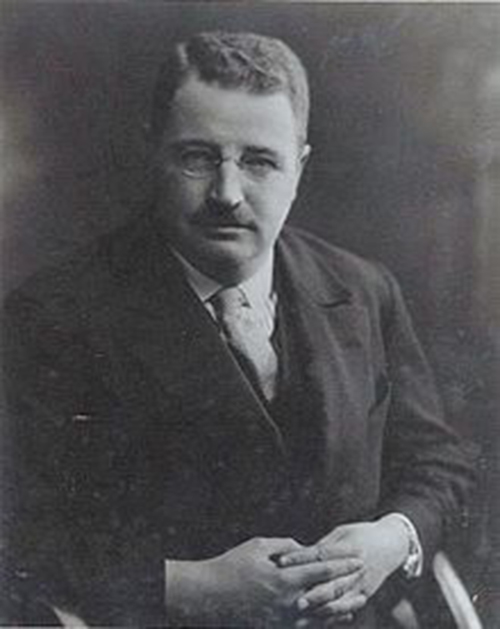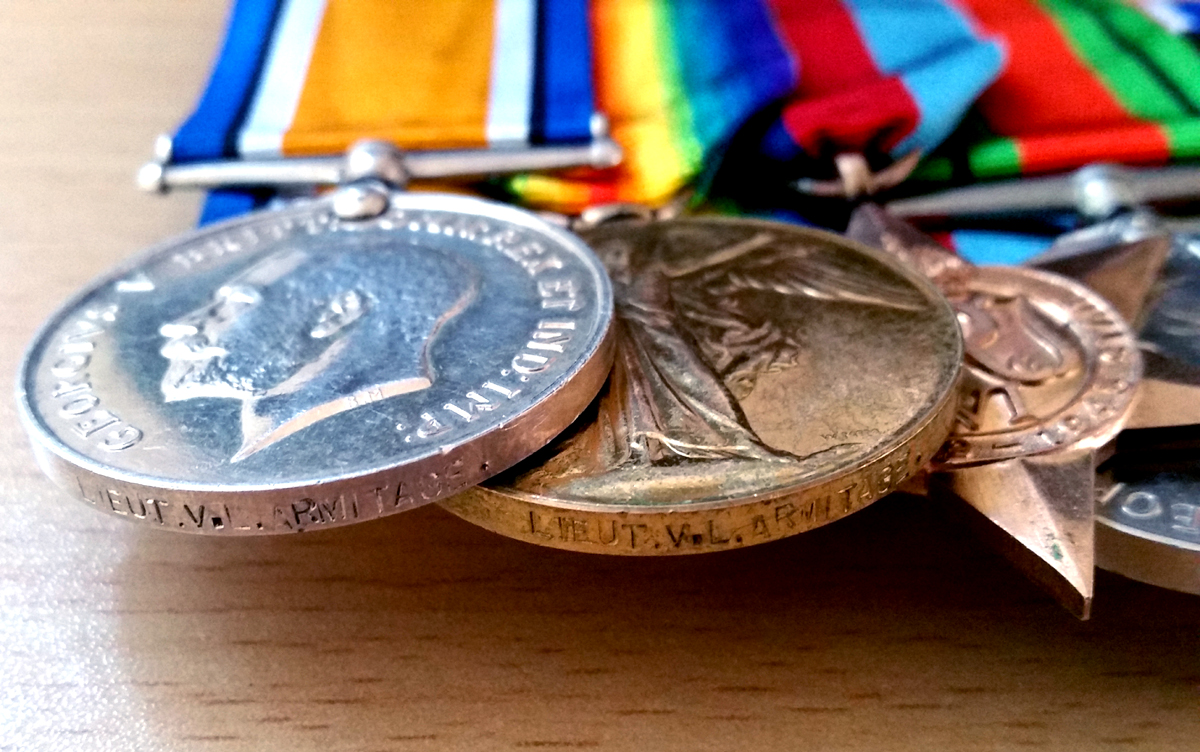Valentine Leathley Armitage
(Click any thumbnail image to view full size)
Family and Background
Born 14th Feb 1888. Son of Rev A.L.Armitage, Educated at King's School, Canterbury. He later attended Balliol College, Oxford, and obtained an B.A. and M.A. in modern languages and later became a lecturer in English in France 1909-1911, before returning to England and taking up a post as a modern language master at The Grange in Folkestone, Kent. He later moved to the fee-paying private Rossall School to continue as a modern language master in 1913.
Valentine Leathley ARMITAGE (Lieutenant Colonel)
Officer Training Corps, 7th Battalion Northumberland Regiment, Provost Corps & Intelligence Corps
British War Medal, Victory Medal, 1929-45 Star, Defence Medal, WW2 War Medal (with "Mentioned in Despatches" oak leaf emblem), 1935 Jubilee Medal, 1937 Coronation Medal, 1953 Coronation Medal, (Territorial) Efficiency Decoration
Home Service and Deploying to France
Valentine was first commisioned on 26th September 1914 as a 2nd Lieutenant (first level officer rank) in the Junior Section, Officer Traning Corps at Rossall School, where he had worked in the Modern Languages department as a schoolmaster since his appointment there in 1913. He later served in the 7th Battalion Northamptonshire Regiment. His battalion, the 7th Northamtonshire Regiment landed in France in September 1915. Valentine would have joined them sometime after January 1916 (from 1916 onwards, the medal index card system used by the Army no longer stated date arrival overseas).
Valentine would have been leading men from the very outset of his arrival in France. The average expected lifespan for 2nd Lts in the first world war was around one month. The junior officers lower life expectancy was mainly due to the fact they were to always "lead from the front". As a result, being one was a risky business. 17% of all junior officers were killed between 1914-19, compared to 15% of "other ranks".
He may have been involved with the rest of the 7th Northants in the German gas attack at Wulverghem, The Battle of Delville Wood and The Battle of Guillemont in 1916, also possibly The Battle of Vimy Ridge, The Battle of Messines and The Battle of Pilkem Ridge in the first half of 1917. What is almost certain is that he saw action at The Battle of Langemarck (16–18 August 1917) as part of the Third Battle of Ypres (Passchendaele).
Promotion, Transfer and Home
He was promoted to 1st Lieutenant (second level officer rank) sometime between the end of July and early November 1917, and it was notified in the quarterly "London Gazette" on the 19th November 1917. It was not uncommon for 2nd Lts to be promoted on the eve of battle, prior to going "over the top", and based on the dates it's entirely possible that happened to Valentine at Langemark.
He was probably back in action at the Battle of Cambrai at the end of 1917. And in 1918; The Battle of St Quentin, The Actions at the Somme Crossings, The Battle of Rosieres, The First Battle of the Avre; The Battle of Cambrai 1918, The pursuit to the Selle, The Battle of the Sambre and The passage of the Grand Honelle. Despite information online to the contrary, there is no evidence to suggest he was ever awarded the Military Cross for gallantry, but it remains an outside possibility and deserves a mention here.
At some point, possibly after the 7th Northants were disbanded after the armistice, he transferred to the Provost Corps, an army corps whose specialties were dealing with matters of custody and detention and working within custodial establishments. As a fluent French and German speaker, he was probably moved there to deal with processing the great many German prisoners. Upon his eventual return to England, he remained a voluntary reservist.
The memorial in Gretton, Northamptonshire (pictured above - click to enlarge) is highly unusual, in that it records seventy two names of men who served in the Great War and returned, in addition to the thirty five men who gave their lives for their country. Valentine is listed on it as one of the men of Gretton to have made it home, pictured below.
A Return to Educating
In 1921 he married Evelyn Muriel Nichols.
In 1922 Valentine took a position as a modern language master at St. Bees School, in Cumbria. In 1925 he was appointed as the first "lay" headmaster of Bloxham School (below shows the school entrance as it looks today). His appointment was an usual one, as until then all headmasters were also members of the Anglian clergy.
As headmaster of Bloxham, Armitage embarked upon a program of reforms to raise the status of the school and transform it from a private school for the middle classes into a traditional public boarding school. He introduced a prefect system with enhanced powers and privileges, and created an environment with strict discipline and the regular use of corporal punishment. He wasn't well liked among some of the teaching staff, as he went about dismissing senior members of staff, in favour of appointing younger, less experienced masters. He introduced a prefect system with enhanced powers and privileges and created an environment with strict discipline, with the prefects using corporal punishment on a regular basis. His reforms included regular daily physical training and an increased emphasis on academic ability. Under his leadership, the school's Officer Training Corps became one of the best in the country.
In 1931 he established the Friends of Bloxham society to raise funds and the profile of the school. Among its early patrons were the Bishop of Oxford, the Earl of Halifax and Viscount Hawarden. His most lasting legacy was an ambitious building program, the largest at Bloxham School since its foundation. Coinciding with the Great Depression, this was extremely contentious. Fees were also reduced to make the school more competitive, and a result Armitage amounted debts of over £14,000 for the school. The Great Hall, Armitage's most notable project, opened in 1937. He was elected a member of the Headmasters' Conference in 1929 in recognition of his work at Bloxham.
He is mentioned frequently in the book "A History of Bloxham School" by Brian S. Smith. In it, it mentions his sometimes short temper, remarking that he rarely used corporal punishment, but choosing the "slipper" if his other methods of discipline had failed. He would often put on his uniform to "take the salute on field days" with the school's Officer Training Corps, or accompany the detatchment on it's trips to Bisley for shooting competiions. He had a "flair for publicity", promoting the school and it's achievements in the press and on newsreels. His wife Evelyn is mentioned in the book as her middle name "Muriel", and comments she was an "excellent hostess". The book has a detailed 23 pages of the school under Valentine's rule. The photo below (click to enlarge) shows Valentine (standing behind the table) at a prizegiving in 1933, among other notable guests present is the prize-giver (wearing the hat), Sir George Arthur, former secretary to Earl Kitchener.
By 1930, he had started to become tired of Bloxham. There is some evidence to suggest he embarked on a round-the-world tour, as on the 30th December 1933 he embarked a ship with his wife Evelyn, leaving Southampton bound for New York. He returns on the 19th April 1938, landing at the port in Liverpool. It may be two seperate, unrelated trips, but a search from the records doesn't bring up any other travel records, so it looks like he was out of the country for 4 1/2 years.
He agonised his future at Bloxham, and by 1938, recognising the signs of the coming war, cultivated his contacts at the War Office. Even though he was by now 50 years of age, he was still a reserve officer with administrative experience and excellent linguistic skills which could be a valuable asset should there be a future oppurtunity for him in a uniformed role. As Britain hastily mobilised for war at the end of August 1939, Valentine received his call-up papers. He left Bloxham without hesitation.
Back in Uniform
He went to France with the British Expeditionary Force (BEF) with what would become the Intelligence Corps. With his comrades all fluent in either French, German or both, as part of 4 FSS (Field Security Section), their main roles were interrogation and intelligence gathering. Any information, maps, diaries or other documents which may be vital for planning the British war effort was first poured over by the Field Security Sections. When the Germans invaded France on 10th May 1940, the BEF found itself withdrawing to the French coast. The 31 Field Security Sections in France at the time found themselves planning for a full-scale evacuation, which became Operation Dynamo, the evacuation from Dunkirk between 26th May and the 4th June 1940.
He was later promoted to the rank of Captain (third level officer rank) and became the Field Security Officer (FSO), Officer Commanding of the the Isle on Man Field Security Section (Intelligence Corps). He was tasked with overseeing the internment camp set-up on the island to hold "enemy aliens". Unlike most of the staff there, the Intelligence Corps played no role in the administration of guarding the camp, their role was to gather data and intelligence from suspected spies, and officer POWs sent there.
Valentine, as a "Temporary Major" (fourth level officer rank) was Mentioned in Despatches, and awarded the Efficiency Decoration (Territorial) in 1944, enabling him to use the post-nominal letters TD.
By July 1947 he retired from the Army, having reached the upper-age limit. He was granted the rank of Honorary Lieutenant-Colonel (fifth level officer rank). In 1950 he took up a teaching post in West Germany, returning the following year.
His wife, Evelyn, died at Limpsfield Hospital, Surrey, in 1954. The following year he married Venetia Mary Stanley Errington Savile, cementing his place in the upper echelons of society. It was her third and final marriage, having been divorced then widowed. Valentine Leathley Armitage died on the 2nd February 1964 in Mere, Wiltshire. His obituary was printed in The Times five days later (shown below - click to enlarge). His wife Venetia never re-married and died on 31st December 1985, aged 92. It was announced in The Times shortly after.
Valentine Leathley Armitage - Listed on the Oxford University Balliol College RegisterValentine Leathley Armitage - Medal Index Card
Valentine Leathley Armitage - Medal Roll Entry
Valentine Leathley Armitage - London Gazette Entry 25 Sept 1914 - Commission (PDF)
Valentine Leathley Armitage - London Gazette Entry 16 Nov 1917 - Promotion (PDF)
Valentine Leathley Armitage - Marriage certificate - Married Evelyn in 1921
Valentine Leathley Armitage - Marriage listing - Married Evelyn in 1921
Valentine Leathley Armitage - Listed in the phonebook of Jun 1925
Valentine Leathley Armitage - Outgoing Passenger List 30 Dec 1933 to New York
Valentine Leathley Armitage - Incoming Passenger List 19 Apr 1938 from Marseilles, France
Valentine Leathley Armitage - in Kelly's Directory 1939 as Head of All Saints (Bloxham) School
Valentine Leathley Armitage - London Gazette Entry 1 Aug 1941 - Transfer (PDF)
Valentine Leathley Armitage - London Gazette Entry 20 Jan 1944 - Efficiency Decoration award (PDF)
Valentine Leathley Armitage - Listed in the phonebook of Nov 1944
Valentine Leathley Armitage - London Gazette Entry 25 Jul 1947 - Retirement (PDF)
Valentine Leathley Armitage - Electoral Roll 1947
Valentine Leathley Armitage - Electoral Roll 1954
Valentine Leathley Armitage - Second Marriage in 1955 to Venetia
Venetia armitage's Listing on the online Peerage directory
Valentine Leathley Armitage - Death record in 1964
Valentine Leathley Armitage - Times Obituary
Venetia Armitage's death confirmed listed in The Times (PDF)
 The Invicta Medal Museum (Online)
The Invicta Medal Museum (Online) 











